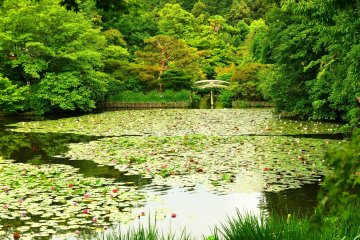
Ryoanji: Kuil Naga Dalam Kedamaian
Masayoshi HiroseKolam Kyoyochi di Kuil Ryoan-ji, Kyoto yang awalnya lebih terkenal daripada 'Rock Garden'

Ryoanji Temple is home to Japan’s most famous Zen stone garden and one of Kyoto’s most iconic scenes. Believed to be built back in the Muromachi period (14th - 16th century), the origin and designer of the garden is still unknown to this day. The stones in the garden are intentionally placed so that one cannot view all 15 stones from any one angle.
The meticulous design of this karesansui (Japanese rock garden) leads many to credit the celebrated artist, Soami, as the garden’s creator—albeit unproven. The 248-square meter garden bears little trace of greenery, and is instead immaculately lined with raked white gravel. The seemingly random placement of the stones adds to the mystique of Ryoan-ji, its abstract layout leaving visitors questioning the meaning and purpose of the garden.
While the garden remains a mystery, the history of Ryoanji Temple is well documented. The temple buildings were originally a Heian Period villa, and were converted into a Zen temple in 1450. Now, Ryoanji is part of the Myoshin-ji school in the Rinzai sect of Zen Buddhism.
In 1994, Ryoanji’s immaculate zen stone garden was recognised as a UNESCO World Heritage Site, and is also designated as a Historic Monument of Ancient Kyoto.
7-minute walk from City Bus Stop Ritsumeikandaigaku-mae (from JR Kyoto Station/Hankyu Oomiya Station) 1-minute walk from City Bus Stop Ryoan-ji-mae (from Keihan Sanjo Station) 7-minute walk from Railway Ryoan-ji Station on the Keifuku Kitano Line

Kolam Kyoyochi di Kuil Ryoan-ji, Kyoto yang awalnya lebih terkenal daripada 'Rock Garden'
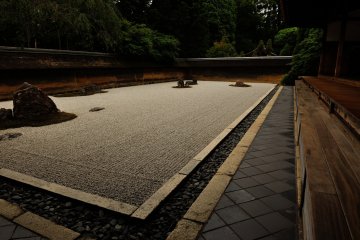
Juni tahun ini saya mengunjungi Kuil Ryoan-ji, kuil "Taman Batu" dan menikmati keindahan yang dikelilingi oleh tumbuhan hijau dan pohon-pohon yang segar
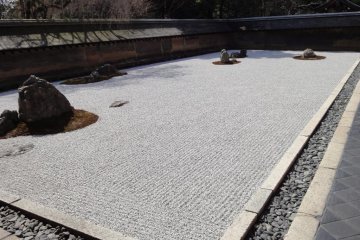
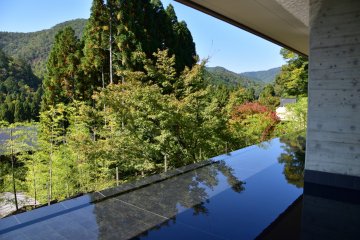
Hotel cantik yang terletak di Shozan Resort Kyoto yang bersejarah.

Staf, lokasi, dan kualitas fantastis - Hotel MyStays Kyoto Shijo

Piece Hostel Sanjo baru saja dibuka pada Juli 2015. Dulunya merupakan sebuah penginapan tradisional a la Jepang, ryokan, yang kemudian direnovasi menjadi sebuah hostel stylish di pusat kota Kyoto. Bisa dibilang ini adalah hostel mewah. Kalau dipikir lagi, hostel itu adalah cara termurah untuk mendapatkan sebuah akomodasi namun ternyata yang namanya hostel gak mesti sempit, kumuh, berisik, atau gak bersih. Konsep luxury hostel yang diusung oleh Piece Hostel Sanjo ini sangatlah terasa, bahkan dari sebelum memasuki lobinya.

Seiring dengan pertumbuhan ketenaran veganisme, khususnya di Jepang, para vegan sekarang bisa menikmati ramen yang sepenuhnya vegetarian dan cabang restoran vegetarian lainnya di negara ini. Berikut adalah tiga tempat yang dapat dikunjungi di Kyoto.

Kedai soba berdiri dengan beragam menu lezat serta harga yang sangat terjangkau yang dapat ditemui di pusat kota Kyoto.
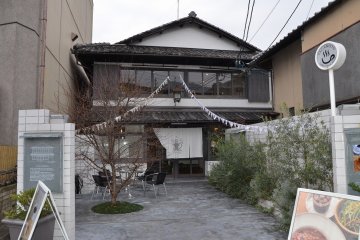
Se-abad sejak Sagano-yu dibangun sebagai pemandian umum pada tahun 1923, tempat ini telah menjadi tempat yang populer bagi penduduk setempat. Seiring waktu berlalu dan gaya hidup masyarakat berubah dengan lebih beragam, Sagano-yu menutupnya pintu untuk terakhir kalinya pada tahun 2004. Namun, pintu-pintu yang sama dibuka kembali untuk umum sebagai direnovasi, modern kafe dan saat ini menikmati popularitas baru.
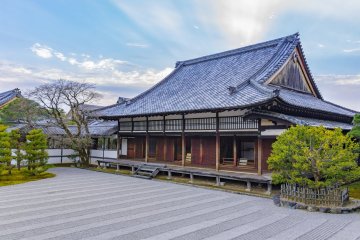
Ninna-ji Temple was founded in 888 and is a Buddhist temple in northeast Kyoto that is closely associated with the imperial family of Japan. It is the main temple of the Omuro school of the Shingon sect of Japanese Buddhism. There are many Omuro School temples throughout Japan and many priests from these temples come to Ninna-ji to attend Buddhist services and to study and train in the main temple of their sect. Ninna-ji Temple is known not only for the building itself, but also for its prime location as a viewpoint for the late cherry blossom. He also has a beautiful Japanese garden from which you can see the famous five-story pagoda. Behind Ninna-ji Temple is the Omuro Pilgrimage, a shorter version of the Shikoku pilgrimage. This route can be covered in about two hours on foot, but is believed to have the same meaning as the Shikoku pilgrimage.
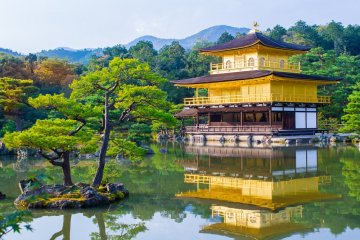
Kuil Kinkakuji juga dikenal sebagai Golden Pavilion (Paviliun Emas) di utara Kyoto. Dua lantai teratas dari paviliun ditutupi daun emas dan dikelilingi dengan kolam yang luas, refleksi dari kuil benar-benar menakjubkan. Anda dapat mengikuti jalan yang akan memandu Anda berkeliling area kuil dan setelah Anda selesai, Anda dapat menikmati teh dan pencuci mulur dikelilingi dengan pepohonan untuk mengistirahatkan tubuh Anda dan membeli beberapa suvenir jika Anda mau di toko suvenir pada akhir perjalanan Anda.

Keishunin (桂春院) is one of the sub-temples of Myoshin-ji containing gardens and a teahouse.